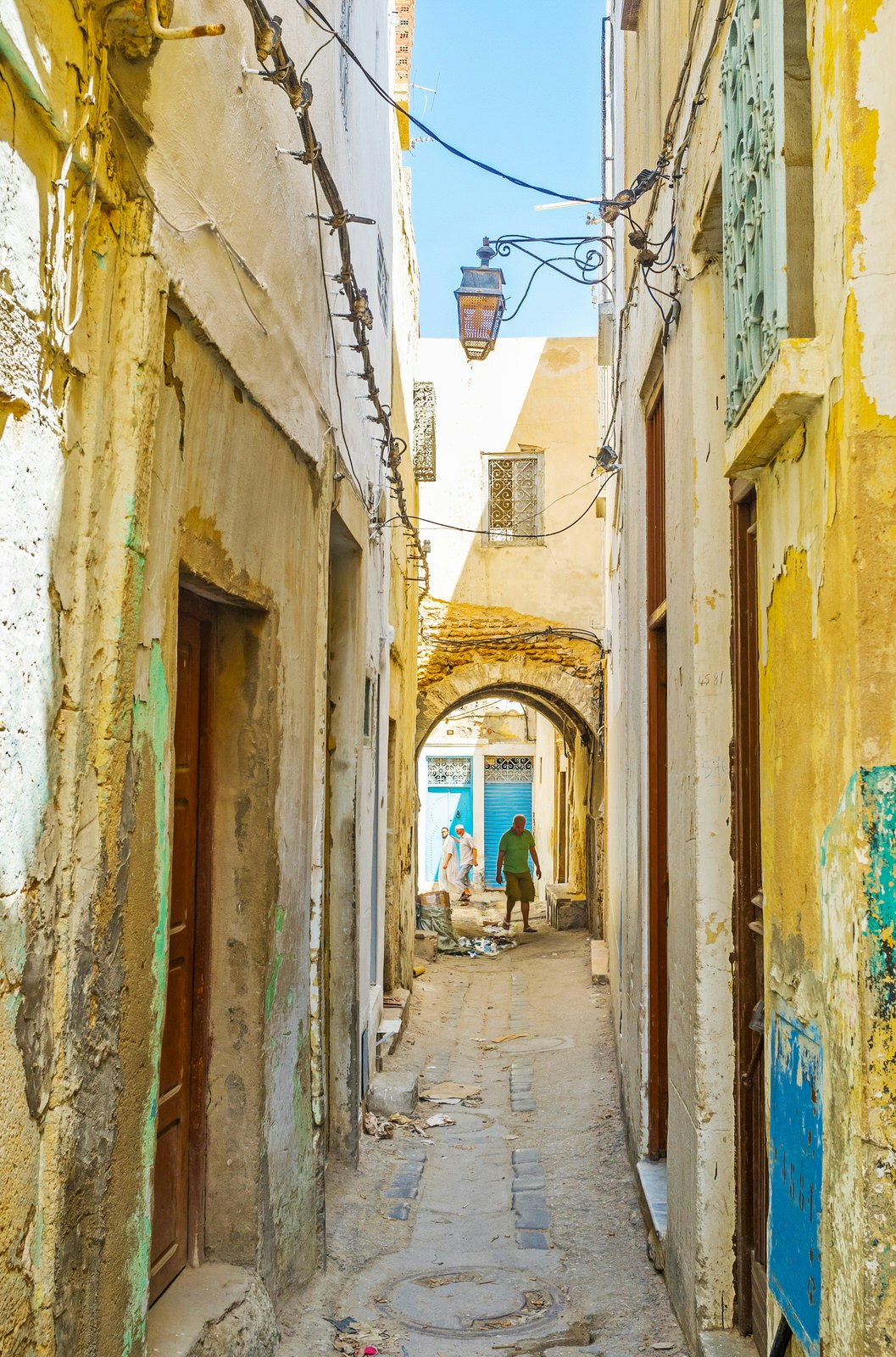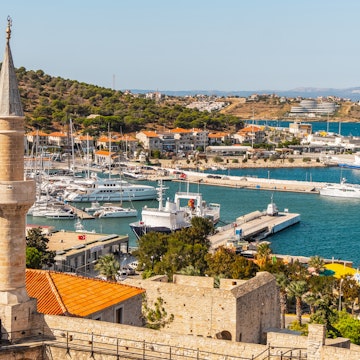

Sfax, Tunisia - September 3, 2015: The medieval fortification of Sfax surrounded by lush gardens with many colorful flowers, Tunisia.
With few touristy sites, industrial Sfax usually falls off travellers’ radars, but its 1200-year-old medina – the smallest in Tunisia – has plenty of history and heritage architecture to entice art lovers, markets and eateries to tempt any foodie, and lots of local colour and atmosphere.

Until recently, Sfax's medina, the ancient walled part of the city, was a place where locals came only to shop during the day and not to linger after nightfall. But in the past few years, this old walled part of the city has been going through a revival and renewal. Since Tunisia's 2011 revolution, locals have been coming together and creating new organisations and associations to inspire change and rejuvenate urban spaces, including the city's historic medina.
Today the Sfax medina is not only one of the best areas in the city to shop but also to enjoy an authentic home-cooked meal or people-watch in one of its lively cafes. Between its millennia-old walls are also fabulous examples of traditional architecture as well as a patchwork of workshops where artisans can be spotted plying traditional crafts. Here’s how to find the soul of Sfax within the meanderings of the medina.

Pause to take in the medina’s buzz at a rooftop cafe
The medina has become a trendy hangout thanks to a few laid back cafes done up with cheerful, rustic decor. In contrast to the usual men-only cafes common across Tunisia, these are places where women can feel welcome and comfortable. The rooftop of Dar Baya, the medina's only heritage hotel, has been transformed into an open-air cafe made up of cosy seating areas adorned with wood and wicker furniture. The cafe is also a cultural space and rooftop venue for storytelling events and concerts by local singers and musicians. Come in the morning for a quiet cup of coffee while the souqs come to life, or arrive just before nightfall to watch the sun dip below the medina's rooftops.
Café Kemour is another popular spot where groups of friends sit around low tables and share news over glasses of strong mint tea. Inside, stone walls and archways are lit by lanterns of coloured glass, but the most popular tables are outside on the open-air terraces spread over several levels, some with views over the medina.

Sample Tunisian specialities at a local eatery
The medina's restaurants and eateries fill up at lunch time when local workers pause for a meal of home-cooked food. Through a stone doorway and up a colourfully tiled stairway is Dar Bellaaj, a new family-run restaurant with welcoming, painted wall tiles and simple bamboo furniture. There's no menu here: that's because it changes daily depending on which vegetables are in season. Try the stew-like tomato-based shakshuka, or a dish of couscous, two typical staples of Tunisian cuisine, prepared in a variety of ways. Vegetarians and vegans will be happy to find many meat-free options here, while carnivores should be satisfied with the huge variety of grilled fish, meat and seafood dishes.
Set in a courtyard of marble floors and brightly painted geometric zellige tilework is the dining room of Adar Lekbira. This beautiful heritage house was the warehouse for a shoe factory before it was transformed into an atmospheric restaurant. On the lunch and dinner menu are traditional Tunisian dishes, but visit in winter and you can sample a locally loved breakfast of cereals mixed with pomegranate, crispy beignets (fritters) served with honey, thick slices of bread doused with olive oil, and sticky, sweet chamya, a dense, rich and crumbly cake made of sesame and sugar.
Seafood lovers should look no further than Restaurant Chouaib Le Pêcheur. Decorated with traditional furniture and colourful floor and wall tiles, this popular eatery serves up what many locals say is the best seafood in the medina.

Explore a heritage house and step back in time
One of the medina's oldest and most beautiful dars (traditional houses) has been tastefully preserved and is open to the public as a museum. Dar Jellouli was built in the 17th century, and today it houses the Regional Museum of Popular Arts and Traditions. A step inside is a step back to the previous century. The house's traditional layout and architectural details have been conserved and painstakingly restored. Opening onto a large central courtyard open to the sky, and decorated with colourful Andalusian-style wall tiles, is a series of doorways. Each one opens into a T-shaped room set with alcoves created by beautifully sculpted and painted wooden panels. Step inside and look up to admire period details, such as the sculpted arches and richly painted wooden ceilings in tones of gold, black and scarlet.
Each room showcases an aspect of traditional everyday life: cooking, bathing, dressing, or receiving guests through informational panels and objects. On the upper floor is an exhibition of traditional costumes while the top floor displays oil paintings and Islamic calligraphy.

Discover the secrets of the medina
Local photographer Houcem Boudaya of Hello Tunisia is on a mission to teach his fellow Sfaxians and visitors alike about the history of the medina. When he's not leading school groups on visits to its historical buildings or navigating the narrow lanes of the souqs with groups of visitors or photographers, he's busy documenting the everyday life of the medina via his photography and video project Beb Jebli. During his guided walks, he leads the intrepid through the medina's souqs and spice markets, pointing out historical details on the way. A mandatory stop is at the Abdennadher Bakery, where the traditional lafif bread is baked in wood-fired ovens. Watch the artisans in action in their workshops, crafting handmade shoes, traditional robes and gowns, tools made of olive wood, musical instruments, and delicately painted trousseau chests.

Practice your haggling skills in the colourful souqs
Enclosed between the walls of the medina is a dizzying collection of more than two dozen souqs or markets. Unlike the souqs of Tunis’ medina and other cities popular with visitors, you’ll find few stalls hawking the usual tourist baubles. This is where locals come to pick up the day’s vegetables, have a pair of shoes resoled or order bespoke wedding finery. Each souq is known for the type of wares it peddles.
Dating back to the 9th century, Souq Erbaa is the oldest and one of the medina’s largest. Wander through the cobbled lanes and plaster arches of this covered market, and you’ll see that this is the place to go for textiles, especially traditional garments. Souq Dhahab is known as the gold market, but don’t expect to find any fine jewels: today most of the objects for sale here are made of less precious silver or wood. Follow your nose to Souq Kamour, and you’ll find perfumed incense, medicinal plants and herbs, and dried plants and flowers used for decoration. From fabrics to buttons and spools of thread, Souq Khayata is a treasure trove for anything related to sewing, tailoring and embroidery. Souq Kriaa hawks mundane household goods like pots, pans and buckets, as well as small appliances, but look up to spot its marvellous red brick arches and domes.
The Funduq El Haddadine (blacksmiths’ lodge) is a medina landmark that has been transformed into an exhibition-cum-market space for handicrafts. Set around a central courtyard open to the air are former storage spaces transformed into workshops. Originally, the funduq was a coach house where travelling traders could upload and store their goods, leave their animals in the courtyard and spend the night on the upper floors. Today, expect to find regular exhibitions of handicrafts like handmade clothing, traditional sweets and decorative objects created by women entrepreneurs.
Check out adventure tours for every traveller from our trusted partners.














